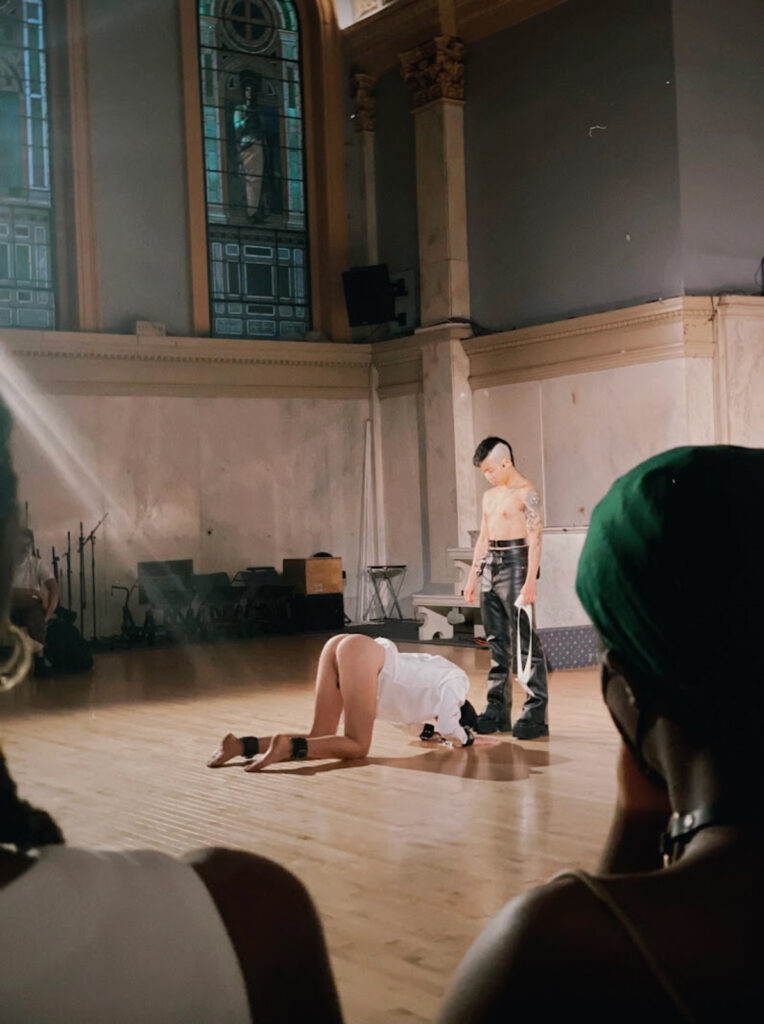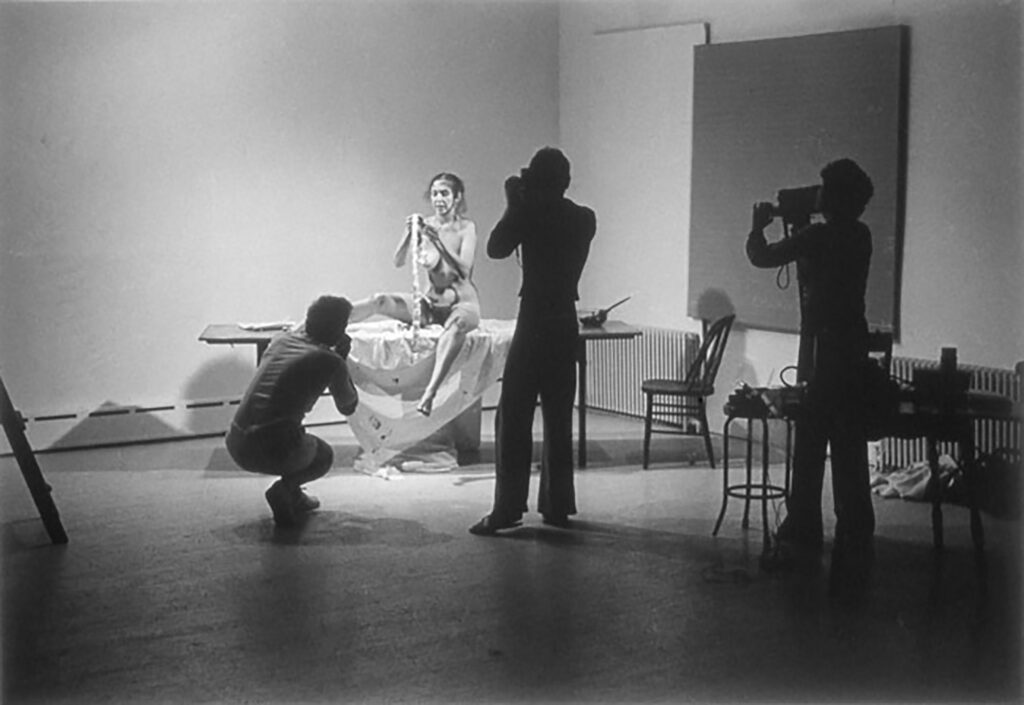Orientalism up your ass
Text by Riven Ratanavanh

Photo by Mengwen Cao
Artist Riven Ratanavanh parses the frisson of sex, race, and power behind his reimagining of Carolee Schneemann’s ‘Interior Scroll’
In 2022, an account called “Asian Guys?” messages me to ask: how are you?
Without havin seen his Grindr profile I wonder if he’s white, but then I think to myself
that doesn’t seem right—his username is too self-proclaimed. Chasers, I reason, aren’t usually all that proud. Not the Asian chasers I’ve encountered.
I look at his profile. He’s Asian. We get chatting. He says he’s looking for something specific.
Looking to train Asian guys to dominate white boys.
I’m not sure yet if my dick is hard but my interest is piqued.
Dominating white boys had already been on my mind. Last year, I proposed to do a redux of Carolee Schneemann’s infamous performance Interior Scroll at the Judson Church Movement Research series. The church was the venue central to the Judson Dance Theater of which Carolee Schneemann was a part. Nearly five decades ago in 1975 she performed Interior Scroll, where she stood on a table nude and pulled out a long sheet of paper from her vagina, reading aloud her response to a film critic’s dismissive, misogynistic remarks about her work. I had first encountered documentation of the piece in my undergraduate studies, and I was struck by how she owned her body, got at the feeling of it. And her anger—it was loud, confrontational, in-your-face.
As an East-Southeast Asian transsexual man—or let me say, transmasculine faggot—I grew up as a girl in Thailand, and I was never taught to be assertive, nor to own or be loud and public about my anger. I thought, if Schneemann, a white cis woman, had a lot to say to a white cis man in the ’70s, then I have a lot to say to what cisness and whiteness are doing in the culture around me now. I wanted to pastiche her method but not reproduce its gender essentialisms. I also wanted to bring race to the fore and tease out how erotic power dynamics are intertwined with colonialism. What was I angry about? I was tired of trying to make art, fuck—exist—without being stereotyped as an innately submissive bottom, sexually, psychically, culturally. Scheemann said ‘fuck the man’ by pulling something out of her vagina, amping up whatever ‘feminine indulgence’ had been used to dismiss her work. I said Fuck the white cis man by putting it up his ass, flipping stereotypical roles.
—
Months into my exchange with Asian Guys?, I discover that he not only has a harem of white boys he lends out to the guys he trains, but also a “brainwasher” who makes homework for the boys—hours-long hypnosis videos. The brainwasher can’t find enough porn of Asian men dominating white men to make these videos with, so he resorts to also using footage of Asian men fucking white women instead.
I can’t believe that’s true, so I check. I realize it had never occurred to me to seek out porn through a racialized filter, and realize people often do. I look up “gay Asian man dominates white man” and its variants on Google. Everything that shows up is the reverse, my words spit out in opposite order, despite my carefully composed search. I had even used the proper search operators to specify that I wanted them one way around and not the other. Among the results: “muscular white man fucks Asian bare in the kitchen”, “Asian bottoms pounded by big white cocks (13 scenes!)”, and “WHITE DADDY DOMINATES ASIAN SUB”. Other videos are less racially explicit in their titling, but less than one out of ten feature an Asian top and white bottom. Even fewer feature an Asian dom and white sub, in stark contrast to the majority of videos that center around white domination.
I understand there is a shortage of images–and sometimes you’ve got to see first in order to be able to do.
—
I’m often fetishized as a trans guy for “being the best of both worlds.” Embedded within this idea is the bioessentialist assumption that I possess both “masculine” and “feminine” physical and emotional traits. With the former comes an implied bottomhood, the latter some sort of ability to hold whatever feelings cis white men have about gender or race (guilt, fear, shame, etc.) unsolicited and at any given moment. In other words, I’m responsible for the invisible emotional labor of producing feelings of comfort, ease, or benevolence for those who, situationally, actually hold more power than me. Like my Google search, this situation finds itself scrambled in opposite order.
This is a fiction projected onto me. I can trace the structures of imperialism, gender essentialism, racial hierarchies, the histories of sexual tourism; I can map out pre-existing cultural imaginations from a white, western cis man’s view.
—
At an artist talk I give in 2021, an older white man in the audience of the Q&A prefaces his compliment about the “sensitivity” present within my art with these exact words: “I love Asian men. They are just naturally more submissive, gentle, well-behaved, and feminine.”
—
There’s an overlap between being Asian and trans, some sort of double-effeminization. If, according to the oversimplified math of stereotyping, Asian = effeminate and transmasculine = not a man, still a girl, does that make me doubly emasculated? If I’m trans and Asian, and trans = exotic and Asian = exotic, does that make me doubly exotic? I’m a guy with a pussy, the ultimate oriental boy.
Considering the mechanics of orientalist tropes and methods of their reversal, I wonder if raceplay is a way to get at it. Can I afford to play? Can I afford to not? To some it’s more of a game than not, and they have the luxury to not have to think about it.
—
I’m at a rave in the center of a dance floor occupied mostly by muscle cis gays. A hand grabs me from behind. Something about this feels reminiscent of girlhood, being groped at the club. I turn to look up at him, his face, and decide to let him grind on me for a moment. After the moment, I turn around to assess him with more discernment. I look down at his crotch, and then back up to see him smirking. I think: Okay, you want that? Well, I want this and more. We make out and I press against him, move to take command. He allows it for a brief moment, then he pulls back and recedes into the crowd, weaving away from me. I sensed he wanted a passive bottom and I’m not surprised. I’m satisfied.
—
Can it be discernible when dominance is a part of play, or when it is racism’s erotic life reproducing itself? How can we distinguish desire from the unknowing performance of racial trauma through sexual means?
Indeed, desire and disdain can be one and the same. In Anne Anlin Cheng’s recent book, Ordinary Disasters: How I Stopped Being a Model Minority, she writes of her experiences being stared at by adult white men at age 14, not knowing that such gazes could have been sexual, that they must have only been filled with scorn or hate. I, too, recall experiences of this as a girl. “Sexual desire does not preclude racial disdain,” writes Cheng from the vantage of an adult. “I recognize those looks could have been, and most likely were, combinations of both.”
Through the eyes of the white man, I can exist at once on both ends of the spectrum of desire and disdain—best of both worlds again.
From the vantage point of an adult, I have also come to recognize these two seemingly opposed emotions co-exist at once within me. A mirror of the white man who gazes upon me with both contempt and desire, I recognize this contradictory mix of emotions within myself, save from a different vantage: I feel scorn for the scorn and stereotypes that come my way, yet I want the privileges of whiteness and the proximity to it. And then, a double bind again—perhaps I even feel scorn for wanting.
The logics of colonialism reproduce themselves through tropes of the submissive, infantilized Asian boy in the hand of white daddy. Scholars like Eng-Beng Lim, who write about the intertwinings of race, sexuality, and empire, trace the histories of these tropes from postcolonial empire through to current-day neoliberal globalization. In Brown Boys and Rice Queens, he writes about the practically unquestioned gay racial fetish for the dominant white top and submissive Asian boy and its different incarnations in time and place spanning Asia to (Asian) America. Saturating all areas of life from the performance stage to everyday life, they enable an entrenched colonial dynamic, allowing within it an easy encoding of the interlocked pairing of contempt and desire, a place for it to hide unquestioned.
So double down on the tropes again: look at me through the stereotype of what we could call the oriental boy: effeminate, submissive, pliant; waiting to be tutored and disciplined by the white daddy. Ready to perform for the white bioessentialist gaze, he’s only ever a bottom.
In refusal, I decide to stage a flipped image, the opposite of the cis white male fantasy: I put the white boy under my control, train him to assume a position, discipline him through punishment if he breaks a rule or fails to perform. I cover his face so he is indistinguishable, so they all look the same. He holds the scroll for me between his teeth as I read out the ridiculous things my fetishizers have said to me, then I put it in his ass.
Carolee said of her own performance that she “didn’t want to pull a scroll out of [her] vagina and read it in public, but the culture’s terror of [her] making overt what it wished to suppress fueled the image.” Our culture’s lack, or even its depletion—of imagery fuelled the image I wished to make overt; of role reversal on a racial level, of the difference between pulling something out and shoving something in. Did it cause terror? The audience at my show was saturated with queer and trans people of color who reported a handful of cis white men in the audience sweating, looking away, or trying not to look.
Yet maybe the image in its overtness oversimplifies the situation behind the scenes. In BDSM, the submissive party is always, in a sense, the one in power: free to say yes or no, to give consent or revoke it. Without these measures, play can become abuse. In making this work, I choose to play, but play involves labor. There’s parts of care in it, in choosing to engage and be in relation with whiteness. In other words, I’m not a mirror image of the white man.
Among my most defining memories growing up in Thailand are the times when white tourists or expats would joke that we all looked the same when they couldn’t pronounce or remember our names. I remember that my Thai-Chinese aunties and uncles would say in jest that all white people look the same. But I also saw them fawn over white people, motivated by a sense of dependency, economic or otherwise. In Thailand, the Asian chaser doesn’t exist. The white man is distinguished, is purchasing power, is cultural capital, is a promise, is a savior. We chase, and the white man is a fetish—but we play in a compromised position, against odds already set.
—
Post show, I share images of the performance on my Instagram, and connect my Instagram to my Grindr profile.
A blank profile writes me: I’m so interested in how a really tall white respectful guy can be incorporated into your kinks… interested in a tall white slave? I’ll do anything kink related for u. But then he becomes terribly persistent, sending message after message in a row without so much as waiting for a response. My initial amusement becomes annoyance becomes concern.
—
I’m back to square one. Even though he’s saying he wants whatever I want, the persistence says he wants me to give him what he wants. Again, I become surface and utility. Call it fetish. It’s a turn off when someone presupposes I’m one thing and not multiple. The performance wasn’t supposed to cement my position as a top or a dom.
If Schneemann was discontent with the expectations of her culture, my discontent is with the restrictive molds of our colonial legacies. I’m not sure if I can reshape colonialism’s erotic life and how it moves through the culture, but at least I can imagine something new for myself, carve out space to be more than.
—
A month after the show, I tell Asian Guys about it. I send him three texts over the course of a month. No response. His profile is also suddenly gone from Grindr. The last time we talked was in May. We had been talking since 2022. There was not a single time he didn’t reply over the span of those two years. And now, nothing.
We never met in the flesh. I have one picture of his face he sent over Grindr that I never screenshotted. If he’s real, he works in financial or management consulting and lives in Queens. I never met the white boy he meant to give to me. I was on the brink of it—wanted to—but couldn’t quite bring myself to. His methods were too rigid for my taste.
For all I know, Asian Guys is a concept. Maybe he never existed. Yet, this show wouldn’t have happened without him, nor my clarified thoughts about race and gender. So in some way, his imaginary lives.


Carolee Schneemann, Interior Scroll, 1975. Women Artists Here and Now, East Hampton, NY. Photographs by Anthony McCall. (c) Carolee Schneemann Foundation
Source https://www.documentjournal.com/2024/12/riven-ratanavanh-sex-race-a/